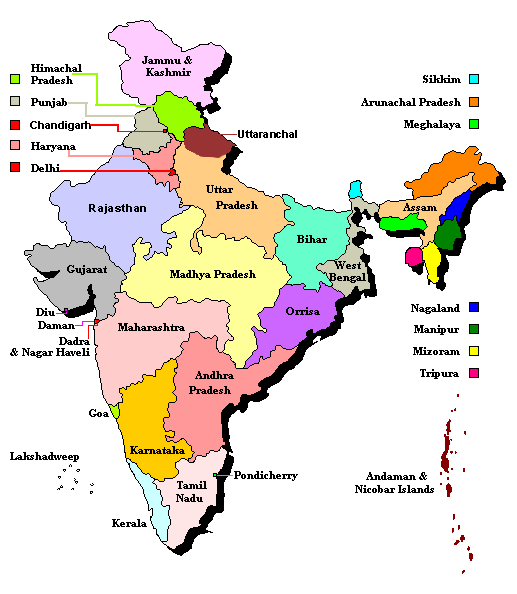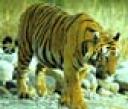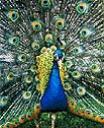History of India. An overview:
The people of India have had a continuous civilization since 2500 B.C., when the inhabitants of the Indus River valley developed an urban culture based on commerce and sustained by agricultural trade. This civilization declined around 1500 B.C., probably due to ecological changes.
During the second millennium B.C., pastoral, Aryan-speaking tribes migrated from the northwest into the subcontinent. As they settled in the middle Ganges River valley, they adapted to antecedent cultures.
The political map of ancient and medieval India was made up of myriad kingdoms with fluctuating boundaries. In the 4th and 5th centuries A.D., northern India was unified under the Gupta Dynasty. During this period, known as India’s Golden Age, Hindu culture and political administration reached new heights.
Islam spread across the Indian subcontinent over a period of 500 years. In the 10th and 11th centuries, Turks and Afghans invaded India and established sultanates in Delhi. In the early 16th century, descendants of Genghis Khan swept across the Khyber Pass and established the Mughal (Mogul) Dynasty, which lasted for 200 years. From the 11th to the 15th centuries, southern India was dominated by Hindu Chola and Vijayanagar Dynasties. During this time, the two systems–the prevailing Hindu and Muslim–mingled, leaving lasting cultural influences on each other.
The first British outpost in South Asia was established in 1619 at Surat on the northwestern coast. Later in the century, the East India Company opened permanent trading stations at Madras, Bombay, and Calcutta, each under the protection of native rulers.
The British expanded their influence from these footholds until, by the 1850s, they controlled most of present-day India, Pakistan, and Bangladesh. In 1857, a rebellion in north India led by mutinous Indian soldiers caused the British Parliament to transfer all political power from the East India Company to the Crown. Great Britain began administering most of India directly while controlling the rest through treaties with local rulers.
In the late 1800s, the first steps were taken toward self-government in British India with the appointment of Indian councilors to advise the British viceroy and the establishment of provincial councils with Indian members; the British subsequently widened participation in legislative councils. Beginning in 1920, Indian leader Mohandas K. Gandhi transformed the Indian National Congress political party into a mass movement to campaign against British colonial rule. The party used both parliamentary and nonviolent resistance and non-cooperation to achieve independence.
On August 15, 1947, India became a dominion within the Commonwealth, with Jawaharlal Nehru as Prime Minister. Enmity between Hindus and Muslims led the British to partition British India, creating East and West Pakistan, where there were Muslim majorities. India became a republic within the Commonwealth after promulgating its constitution on January 26, 1950.
After independence, the Congress Party, the party of Mahatma Gandhi and Jawaharlal Nehru, ruled India under the influence first of Nehru and then his daughter and grandson, with the exception of two brief periods in the 1970s and 1980s.
Prime Minister Nehru governed India until his death in 1964. He was succeeded by Lal Bahadur Shastri, who also died in office. In 1966, power passed to Nehru’s daughter, Indira Gandhi, Prime Minister from 1966 to 1977. In 1975, beset with deepening political and economic problems, Mrs. Gandhi declared a state of emergency and suspended many civil liberties. Seeking a mandate at the polls for her policies, she called for elections in 1977, only to be defeated by Moraji Desai, who headed the Janata Party, an amalgam of five opposition parties.
In 1979, Desai’s Government crumbled. Charan Singh formed an interim government, which was followed by Mrs. Gandhi’s return to power in January 1980. On October 31, 1984, Mrs. Gandhi was assassinated, and her son, Rajiv, was chosen by the Congress (I)–for “Indira”–Party to take her place. His government was brought down in 1989 by allegations of corruption and was followed by V.P. Singh and then Chandra Shekhar.
In the 1989 elections, although Rajiv Gandhi and Congress won more seats in the 1989 elections than any other single party, he was unable to form a government with a clear majority. The Janata Dal, a union of opposition parties, was able to form a government with the help of the Hindu-nationalist Bharatiya Janata Party (BJP) on the right and the communists on the left. This loose coalition collapsed in November 1990, and the government was controlled for a short period by a breakaway Janata Dal group supported by Congress (I), with Chandra Shekhar as Prime Minister. That alliance also collapsed, resulting in national elections in June 1991.
On May 27, 1991, while campaigning in Tamil Nadu on behalf of Congress (I), Rajiv Gandhi was assassinated, apparently by Tamil extremists from Sri Lanka. In the elections, Congress (I) won 213 parliamentary seats and put together a coalition, returning to power under the leadership of P.V. Narasimha Rao. This Congress-led government, which served a full 5-year term, initiated a gradual process of economic liberalization and reform, which has opened the Indian economy to global trade and investment. India’s domestic politics also took new shape, as traditional alignments by caste, creed, and ethnicity gave way to a plethora of small, regionally based political parties.
The final months of the Rao-led government in the spring of 1996 were marred by several major political corruption scandals, which contributed to the worst electoral performance by the Congress Party in its history. The Hindu-nationalist Bharatiya Janata Party (BJP) emerged from the May 1996 national elections as the single-largest party in the Lok Sabha but without enough strength to prove a majority on the floor of that Parliament. Under Prime Minister Atal Bihari Vajpayee, the BJP coalition lasted in power 13 days. With all political parties wishing to avoid another round of elections, a 14-party coalition led by the Janata Dal emerged to form a government known as the United Front, under the former Chief Minister of Karnataka, H.D. Deve Gowda. His government lasted less than a year, as the leader of the Congress Party withdrew his support in March 1997. Inder Kumar Gujral replaced Deve Gowda as the consensus choice for Prime Minister of a 16-party United Front coalition.
In November 1997, the Congress Party in India again withdrew support for the United Front. New elections in February 1998 brought the BJP the largest number of seats in Parliament–182–but fell far short of a majority. On March 20, 1998, the President inaugurated a BJP-led coalition government with Vajpayee again serving as Prime Minister. On May 11 and 13, 1998, this government conducted a series of underground nuclear tests forcing U.S. President Clinton to impose economic sanctions on India pursuant to the 1994 Nuclear Proliferation Prevention Act.
In April 1999, the BJP-led coalition government fell apart, leading to fresh elections in September. The National Democratic Alliance-a new coalition led by the BJP-gained a majority to form the government with Vajpayee as Prime Minister in October 1999.
FLAG OF INDIA and The National Anthem of India
THE NATIONAL ANTHEM OF INDIA
Jana-Gana-Mana
(Thou Art the Ruler of All Minds)
The Indian National anthem, composed originally in Bengali by Rabindranath Tagore, was adopted in its Hindi version by the Constituent Assembly as the National Anthem of India on 24 January 1950. It was first sung 27 December 1911 at the Calcutta session of the Indian National Congress. The complete song consists of five stanzas. The lyrics were rendered into English by Tagore himself.
N A T I O N A L A N T H E M O F I N D I A
” Jana Gana Mana Adhinayaka Jaya He
Bharat Bhagya Vidhata
Punjab Sindh Gujarat Maratha
Dravida Utkala Banga
Vindhya Himachal Yamuna Ganga
Ucchala Jaladhi Taranga
Tubh Shubha Name Jage
Tubh Shubha Ashisha Mange
Gahe Tubh Jaya Gata
Jan Gan Mangaldayak Jay He
Bharat Bhagya Vidhata
Jaye He ! Jaye He ! Jaye He !
Jaye,Jaye,Jaye,Jaye He “
Translation of The national anthem- Jana Gana Mana In English
Thou are the ruler of the minds of all people, dispenser of India’s destiny.
The name rouses the hearts of Punjab, Sind, Gujurat and Maratha. Of the Dravid and Orissa and Bengal.
It Echoes in the hills of Vindhyas and Himalayas, mingles in the music of Yamuna and Ganga and is chanted by the waves of the Indian Sea.
They pray for your blessing and sing thy praise. The salvation of all peaople is thy hand, thou dispenser of India’s destiny. Victory, Victory, Victory to thee.
The Jana Gana Mana was composed by Shri Rabindranath Tagoreand first sung at the Calcutta session of the Indian National Congress on December 27th, 1911. It was adopted as the National Anthem of India on 24th January, 1950 by the Constituent Assembly. The first stanza( out of five stanzas) of the song forms the National Anthem.
Jai Bharat Mathe
VANDE MATARAM …The National Song of India
…composed by Bankim Chandra Chatterji has an equal status as the Jana Gana Mana.
FLAG OF INDIA
THE NATIONAL FLAG OF INDIA is in tricolour of deep saffron(Kesari) at the top, white in the middle and dark green at the bottom in equal propotions.The flag is a horizontal tricolour in equal proportion of deep saffron on the top, white in the middle and dark green at the bottom. The ratio of the width to the length of the flag is two is to three. In the centre of the white band, there is a wheel in navy blue to indicate the Dharma Chakra, the wheel of law in the Sarnath Lion Capital. Its diameter approximates the width of the white band and it has 24 spokes. The saffron stands for courage, sacrifice and the spirit of renunciation; the white, for purity and truth; the green for faith and fertility. The design of the National Flag was adopted by India’s constituent assembly on 22nd july, 1947. It’s use and display are regulated by a code. The Indian flag symbolizes freedom. The late Prime Minister Pandit Nehru called it a flag not only of freedom for ourselves, but a symbol of freedom for all people.
Some interesting flag facts : Courtesy sitagita.com
Our national flag was hoisted on Mt. Everest, the highest peak in the world, on May 29 1953, along with the Union Jack and the Nepalese National flag. In 1971, the Indian flag, went into space on board Apollo-15. It flew into space as a medallion on the spacesuit worn by Cosmonaut Wing Commander Rakesh Sharma, during the Indo-Soviet joint space flight in April 1984. On January 9 1982, the first Indian Antarctica Expedition planted the first Indian flag over Dakshin Gangotri. It was hoisted for the first time on the South Pole on January 17, 1989, by Colonel J.K. Bajaj. On April 21, 1996, at 0352 hrs (IST), the first Indian and perhaps the first in Asia, Sqdn. Ldr. Sanjay Thapar, holder of many national and international records in parajumping and skydiving, jumped from an altitude of 10,000 ft from an MI – 8 helicopter and hoisted the Indian tricolour on the North Pole. On Sept 28, 1985, the Tiranga set out on an around the world sailing expedition on board Trishna under Colonel T.P.S. Chowdhry and successfully returned home on January 10, 1987, cruising the high seas of the world and covering over 30,000 nautical miles in 470 days.
National Emblem of India
The National emblem is a symbol of contemporary India’s reaffirmation of its commitment to world peace and goodwill.
The National Emblem of India is a replica of the Lion of Sarnath, near Varanasi in Uttar Pradesh State. The Lion Capital was erected in the 3rd century BC by Emperor Ashoka to mark the spot where Lord Buddha first proclaimed his gospel of peace and emancipation..
It is symbolic of India’s reaffirmation of its ancient commitment to world peace and goodwill. In the original, there are four lions, standing back to back, mounted on a abacus with a frieze carrying sculptures in high relief of an elephant, a galloping horse, a bull and a lion separated by intervening wheels over a bell-shaped lotus. Carved out of a single block of polished sandstone, the capital is crowned by the Wheel of the Law (Dharma Chakra).
In the state emblem adopted by the Government of India on 26 January 1950, only three lions are visible, the fourth being hidden from view. The wheel appears in relief in the center of the abacus with a bull on the right and a horse on the left and the outlines of the other wheels on extreme right and left. The bell-shaped lotus has been omitted.
The four lions (one hidden from view) – symbolising power, courage and confidence – rest on a circular abacus. The abacus is girded by four smaller animals – guardians of the four directions: the lion of the north, the elephant of the east, the horse of the south and the bull of the west.The abacus rests on a lotus in full bloom, exemplifying the fountainhead of life and creative inspiration. The motto ‘Satyameva Jayate’ inscribed below the emblem in Devanagari script means ‘truth alone triumphs’
National Animal of India-THE TIGER.
The magnificent Tiger Panthera tigris (linnaeus), the national animal of India, is a rich-colored well-striped animal with a short coat. The combination of grace, strength, power has earned the tiger great respect and high esteem. Indian tigers are famous all over the world and one of the main attractions for the lovers of wild life. They are the crowning glory and the light of the Indian wild life.
Tough, muscular, majestic tigers roam about the Sunderbans of Bengal “burning bright in the darkness of the night.” The natives of the forest worship the tiger as the deity that gives them honey and wax. The Sunderbans are their main habitat for their thick forests of Sunder trees. They feed on fish, cattle and sometimes human beings. The man-eaters are the most dreaded of all wild beasts. It is a common belief that a tiger does not harm anyone who has offered prayers to him. Tigers are fast runners, excellent swimmers and their eyesight is strong.
To check the dwindling population of tigers in India, which came down to just 1,827 in 1972, massive conservation program was initiated in April 1973, known as the ‘Project Tiger’. This project aims to maintain a viable population of tigers in India for scientific, economic, aesthetic, cultural and ecological values. Since then, the tiger population has shown a gradual increase and the census of 1989 puts the tiger population of the country at 4,334. So far, 19 tiger reserves have been established in the country under this project, covering over 29, 716 sq. km. forest area
National Bird of India-THE PEACOCK
Peacock is a large and majestic bird. It has got a long and beautiful tail. Both the peacock and the hen have crest. But the crest of hen is smaller in size. The main body of the cock is mottled brown in color. Especially, the metallic green color found on the lower neck is very attractive. Though peacocks are beautiful looking birds their calls are loud and coarse.
They move in-groups and they are normally spotted in the forests, villages and nearby fields. They are shy in nature. It feeds on lizards, snakes, grains and insects. The hen lays a maximum of five eggs, which are in pale cream color.
The significance of peacock is attached to cultures of India, Far East, Ancient Persia, Greek and Christian. In Hinduism, the image of the god of thunder, rains and war, Indra, was depicted in the form of a peacock. In south India, peacock is considered as a ‘vahana’ or vehilce of lord Muruga. The figure of peacock is painted in various Islamic religious buildings. In Christianity, the peacock was also known as the symbol of the ‘Resurrection’.
In India people believe that whenever the cock spread its tails in an ornamental fashion, it indicates that rain is imminent. In a way it is partly true. At the sight of dark clouds the bird outspreads its tail and starts dancing in rhythmic fashion. Most of the folklore including Bharatha Natyam has got special dancing poses for the peacock dance.
National Flower of India- THE LOTUS
Among the various flowers of Indian sub-continent, the flower Lotus is regarded with divinity and grace. Often, Goddesses Lakshmi and Saraswathi are associated with the flower lotus. Even Lord Siva, who wanted to escape the wrath of the Lord Saneeswaran, morphed himself into the shape of a bee and took asylum inside a lotus. Buddhists regard this flower as a sacred one.
Lotus symbolizes purity, beauty, majesty, grace, fertility, wealth, richness, knowledge and serenity. They are found in white and pink colors in general and they grow in shallow and murky waters. Some blue colored flowers are also sighted. These flowers enjoy a warm sunlight and intolerant to cold weather. Hence they cannot be seen blossoming in the winter. The floating leaves and flowers have long stems, which contains air spaces to maintain buoyancy.
The plant is having various uniqueness attached to it. Though the large leaves of the plant are floating on the surface of the water, even a drop of water is not accommodated on top of the leaves. Perhaps, they are teaching the human beings, to lead a life of non-attachment and avoid the worldly pleasures.
Depending upon the level of water in the tank, the stems will rise. In this fashion, it is guiding the human beings to rise upto the situation leading to a genuine elevation in their lives. As the world famous ‘Thirukural’ says,
“Vellathanayathu malar neetam manthartham
ullath thanyathu ouyarvu”
signifying, in relation with the water level of a tank, the stem will rise. In the same way, depending upon their ambitions and thoughts, human beings can elevate themselves in their life.
In Indian religious epics, references of lotus are made, in relation with eyes and feet of divine persona. For instance “Kamala Kannan” referring Lord Krishna with the contextual meaning, a person having eyes with the color of the pink lotus. Also, it is coupled with the feet of deities. “Kamala Patham” means lotus feet implying the feet of the god. “Charan Kamala Patham” implying, submit oneself in totality, at the lotus feet of the god.
National Tree of India- THE BANYAN TREE.
THE BANYAN TREE-Called the Indian fig tree( Ficus bengalensis) grow over a large area. The roots then give rise to more trunks and branches. Because of this characteristic & longevity, the Banyan tree is considered immortal & sacred and is an integral part of the myths and legends in India. Even today, the banyan tree is the focal point of village life and the village council meetings under the shade of this huge shade-giving tree.
National Fruit of India-THE MANGO
The fruit Mango,of the tree Mangifera indica, is one of the most widely cultivated fruits of the tropical world. This juicy, delicious fruit is a rich source of Vitamins A, C and D. In India there are hundreds of varieties of mangoes, in different sizes, shapes and colours etc. Mangoes, have been cultivated in India since time immemorial. The famous Indian poet Kalidasa sang its praises.King Alexander relished its taste, as did the Chinese traveller Hieun Tsang. Akbar, the Moghal emperor planted over 100,000 mango trees in Darbhanga, known as Lakhi Bagh(India).














0 Comments:
Post a Comment